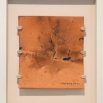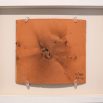蔡國強(ツァイ・グオチャン) CAI Guo-Qiang 1957–
- SMOCAのためのエディション、No.20 2013年 火薬・中国泉州の瓦 25x22.5cm
Edition for SMOCA, No.20 2013 gunpowder, roofing tile from Quanzhou 25x22.5cm
2013年4月28日、福島県いわき回廊美術館(SMoCA)開館祭オープニングの際に制作された99作品の一つ - SMOCAのためのエディション、No.30 2013年 火薬・中国泉州の瓦 22x25cm
Edition for SMOCA, No.30 2013 gunpowder, roofing tile from Quanzhou 22x25cm
2013年4月28日、福島県いわき回廊美術館(SMoCA)開館祭オープニングの際に制作された99作品の一つ
蔡國強は1957年中国・福建省生まれ。上海演劇大学卒業後、翌年に日本に渡り、筑波大学で学びながら作家活動を開始。95年以降はニューヨークを拠点にする。火薬を爆発させて描いた「火薬絵画」やパフォーマンスのほか、中国やアジア文化を背景としたインスタレーションを多く手がける。主な作品に、火薬と導火線を使った《万里の長城を1万メートル延長するプロジェクト》(1993)やネバダ核実験場などを舞台に火薬で小さなキノコ雲をつくる《キノコ雲のある世紀》(1996)など。2005年のヴェネチア・ビエンナーレでは、初出展した中国館のキュレーターを務めた。08年北京夏季オリンピックの開会式ではアーティスティックディレクターを務め、北京市内を打ち上げ花火《歴史の足跡》が縦断する演出を手がけ話題を呼ぶ。
日本では、香川県直島で各国の人々がジャグジー風呂につかる《文化大混浴》(1998)、広島の原爆ドーム付近で黒い花火を打ち上げた《黒い花火:広島のためのプロジェクト》(2008)を展開するほか、20年に及ぶ交流のある福島県いわき市では、いわきの「廃船」を使った作品なども手がける。1999年 第48回ヴェネチア・ビエンナーレ金獅子賞、2007年第7回ヒロシマ賞、09年第20回福岡アジア文化賞、12年第24回高松宮殿下記念世界文化賞など受賞歴多数。
(美術手帖 ウェブサイトより引用)
Born in 1957 in Quanzhou, Fujian Province, China, Cai Guo-Qiang received a BFA in stage design from the Shanghai Drama Institute in 1985. He resided in Japan from 1986 to 1995, after which he moved to New York, where he has lived and worked ever since. In 1984 Cai first began experimenting with gunpowder and in 1989 staged the first of his public explosion events, which would become integral to his practice. He mines gunpowder’s charged identification with China, where it was invented, to create allegorical, sociopolitical commentaries that riff on saltpeter’s paradoxical associations with ancient medicine, ritual fireworks, and modern violence. By using explosives as pyrotechnical events outdoors or as a medium on paper, Cai recast a quintessential Chinese material to stake his contribution to the emerging global art scene. He also made the case that the catharsis of destruction and creation links art and war. In his varied practices and materials, Cai draws freely from ancient mythology, military history, Daoist cosmology, Maoist revolutionary tactics, Buddhist philosophy, pyrotechnic technology, Chinese medicine, and images of terrorist violence.
< from GUGGENHEIM - Collection Online >






